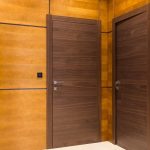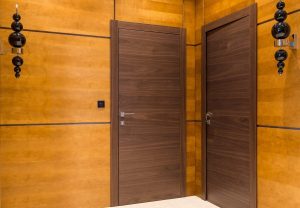Answering the most common questions of fire-rated doors!

Fire-rated door sets are essential in commercial and industrial facilities to prevent fires from spreading. Fire-rated door sets are available in various styles, utilising strips that expand when exposed to fire. When buying one, it is essential to know some information about them. We aim to dispel some myths about fire-rated door sets by answering frequently asked questions. Let’s take a look.
BEWARE, THAT HUGE HULK OF WOOD HAS MUCH MORE TO IT THAN YOU THINK.
How do fire doors work, and what are their benefits?
In a building, a fire door is a safety device that, when closed, compartmentalises fire and smoke, slowing their spread throughout a building. In contrast, they provide a route to escape and give the emergency services a secure way to enter a building when they are open.
As if dominoes were falling. But it wasn’t the pizza.
Each piece of fire continues to fall, so the fire continues to spread as it spreads like a domino effect. You would soon see the chain reaction halt if you placed an obstacle in the way. We can now move forward because the fire is contained.
Buildings contain the fire and smoke using fire-resistant materials as part of their construction.
Is a fire door capable of withstanding fire and smoke for an extended period?
Fire door ratings indicate whether a door will hold out against fire for a long time. According to the Australian Standard, the most common fire-resistance ratings are FD 30 and FD 60, which protect against fire consecutively for 30 minutes and 60 minutes.
The minimum fire-resistance rating you should ever find is 30 minutes, but you can see ratings that allow up to 120 minutes. Installation of fire doors should be based on the design of the building and the type of operation it performs every day.
However, it is essential to realise that fire doors can fail; they are not infallible. Keeping a fire door closed, undamaged, and maintained allows it to perform as it should!
A fire door consists of what components?
Fire doors are comprised of various components. Typically, you will recognise the following:
Door leaf – The door itself must be constructed of a fire-resistant material suitable for the building it gets installed in.
Door frame – the frames must be compatible with their counterparts, the leaves and must be appropriately fitted to ensure the gaps are accurate and meet the required size.
Smoke/Fire seals – when the door leaf is closed, these seals should fill every gap around it.
Intumescent strips – in contrast to smoke seals, which remain in their original form around the frames of fire doors to prevent the spread of smoke and fire, intumescent strips expand when exposed to extreme heat, sealing the gap even further.
Hinges need to be installed correctly and with appropriate hinge pads, or the door won’t open or close correctly.
Door closer – A fire door’s top is usually equipped with a metal box attached to an arm that automatically assists with the door closing, although not all fire doors have this feature.
What is the purpose of fire doors?
It is the smoke rather than the fire itself that affects people. Smoke and
fire-resistant fire doors are invaluable in this situation.
A smoke seal around the door edge or frame and the frame prevents smoke from getting through, preventing smoke inhalation. Intumescent strips expand several times their original size when exposed to heat, preventing fire and smoke from entering the door.
The fire safety strategy for your building depends heavily on them.
What is the process of manufacturing fire rated door sets?
Fire-rated door sets are manufactured using different techniques by different manufacturers. However, every manufacturer aims to reach the desired rating. A typical fire rating is FD30, FD60, FD90, and FD120.
Fire Doors are the FDs in this rating, and the numbers describe the number of minutes a fire-resistant doorset can retard the spread of the fire.
Fire door sets are tested in what ways?
Independent third-party companies perform testing to evaluate the fire rating provided by the manufacturer for the given fire-rated doors. To validate the manufacturer’s rating, tests are conducted to measure the duration during which a fire-resistant doorset can prevent a fire.
What is the purpose of fire-rated door sets?
Various industrial, commercial and residential buildings are vulnerable to fire, so fire-rated doors are necessary. When a fire or smoke outbreak occurs, fire-rated doorsets help contain the situation. There are many places where fire-rated door sets are essential, including commercial kitchens, laboratories, manufacturing facilities, refineries, research establishments, and educational institutions.
Is it possible to repair fire doors, or do we need to replace them?
It depends on how badly the door has been damaged. It is possible to reposition the door if it is binding on the frame and maintain compliance. A fire door has been designed and engineered to provide maximum protection; it must be replaced if it has split, broken, or the internal core materials have been damaged or loose.
What to do if we want to reuse the existing lock & closer on a new fire door?
That depends on;
- The core of an existing fire door. Not if asbestos is present.
- Tested & approved fire door locks should be used.
- The lock(s) and closer should be in good working condition.
- Where and how to use door hardware. (If door locks & closers are close to saltwater, exposed to the weather, or used often, they must be fire-tested.)
Is it possible to tell whether the old fire doors contain asbestos?
Many test laboratories in Australia will accept a sample of the door’s core. This test is estimated to cost between $100.00 and $300.00!
Australia manufactured fire doors with asbestos cores between 1948 and 1986.
Thousands of fire doors in warehouses around the country were sold and installed in the 1990s when asbestos was banned in fire doors.
A lab test report on the core is the only way to determine the asbestos content of the existing fire doors. Calcium Silicate is also a product that has been used for fire doors and is similar to asbestos cores, but is safer & is still made around the world today.
Is a professional qualified installer needed to install the fire door, or can anyone do it?
The answer is no. Fire doors are different from hollow or timber doors. They are fire-resistant and designed to protect property as well as lives. Fire Doors & Frames should be done only by qualified carpenters, builders, or accredited fire door installers.
Fire Doors have regulation gaps & clearances that must be installed by manufacturing details & Australian Standards. Contact us if you have any questions.









